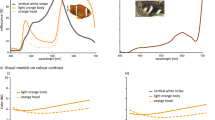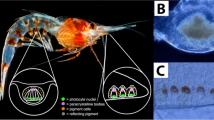Abstract
THE poeciliid Belonesox belizanus Kner has a mixture of two visual pigments in its retina. One of these is based on vitamin A1 (λmax = 498 mµ), the other on vitamin A2 (λmax = 521 mµ)1,2. Like the cyprinids Scardinius3 and Notemigonus2 the proportions of these pigments in the retina vary throughout the year, there being more of the vitamin A2-based pigment in the winter and less in summer2. As in Notemigonus4, there is considerable variation of retinal visual pigment composition among individuals of Belonesox caught at the same time and in the same place (Bridges, C. D. B., unpublished observations).
This is a preview of subscription content, access via your institution
Access options
Subscribe to this journal
Receive 51 print issues and online access
$199.00 per year
only $3.90 per issue
Buy this article
- Purchase on Springer Link
- Instant access to full article PDF
Prices may be subject to local taxes which are calculated during checkout
Similar content being viewed by others
References
Bridges, C. D. B., Nature, 203, 303 (1964).
Bridges, C. D. B., Nature, 203, 191 (1964).
Dartnall, H. J. A., Lander, M. R., and Munz, F. W., Progress in Photobiology, 203 (Elsevier, Amsterdam, 1961).
Bridges, C. D. B., Vision Res., 4, 233 (1964).
Author information
Authors and Affiliations
Rights and permissions
About this article
Cite this article
BRIDGES, C. Visual Pigments in a Fish exposed to Different Light-Environments. Nature 206, 1161–1162 (1965). https://doi.org/10.1038/2061161a0
Issue Date:
DOI: https://doi.org/10.1038/2061161a0
This article is cited by
Comments
By submitting a comment you agree to abide by our Terms and Community Guidelines. If you find something abusive or that does not comply with our terms or guidelines please flag it as inappropriate.



